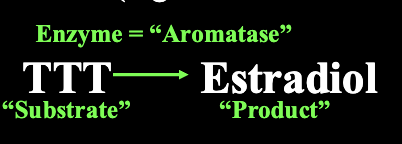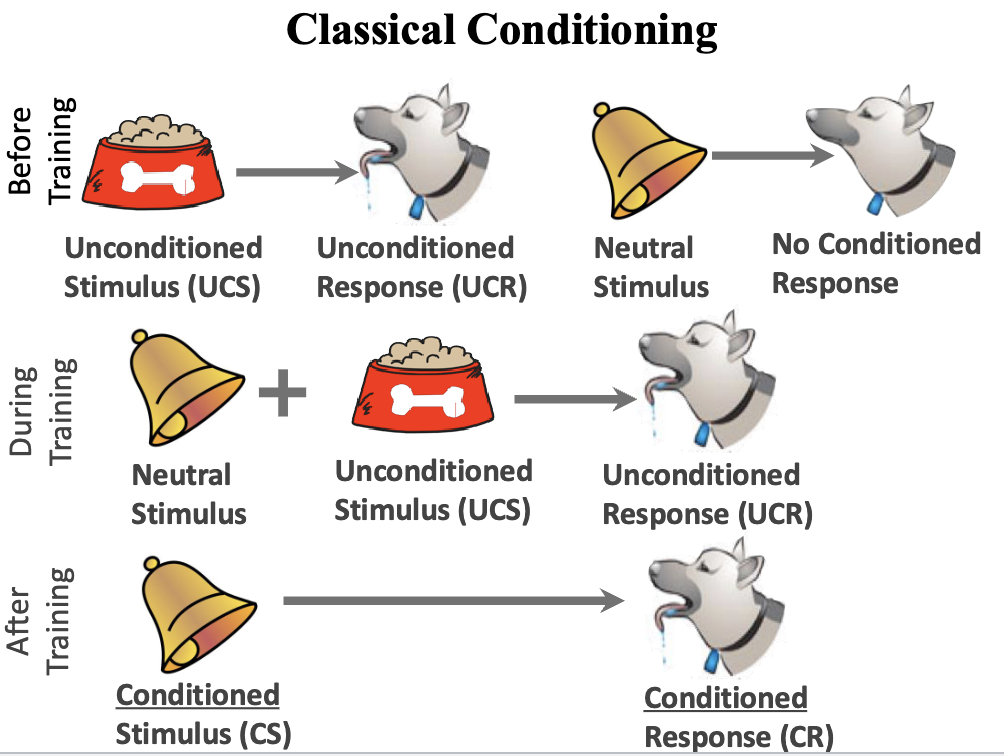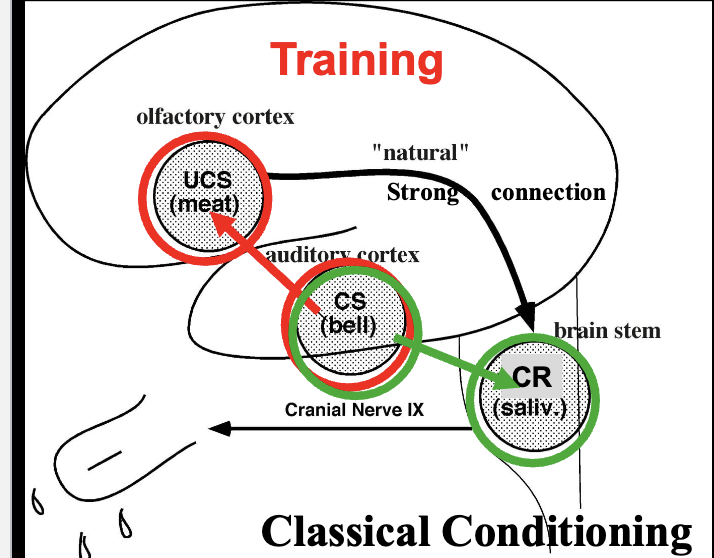PSYC 106 Final
1/124
There's no tags or description
Looks like no tags are added yet.
Name | Mastery | Learn | Test | Matching | Spaced |
|---|
No study sessions yet.
125 Terms
Exocrine glands
secrete stuff locally, sweat, saliva, breast milk (through ducts)
Endocrine glands
secrete hormones into the blood.
Hormones are carried in blood to organs of the body where they influence cell activity
hormnes hae global and long lastin
Hormones
hormones have global and long lasting effects.
Global since they are carried in the blood to organs in the body
Neurotransmitters
have lova, short lived effects
Hormones that are also neurotransmitters
Adrenaline = epinephrine
but we call it adrenaline when it is released as a hormone from the adrenal gland. We call it epinephrine when it's
released as a neurotransmitter for neuro communication
Noradrenaline = norepinephrine
Hypothalamus & Pituitary Gland
Hypothalamus releases hormones (e.g., gonadotropin-releasing hormone) into the pituitary gland, and then.... The pituitary releases hormones (e.g., FSH and LH) into the bloodstream, which travel to other endocrine glands (e.g., ovaries in females), and then... The other endocrine glands (e.g., ovaries in females) release hormones into the bloodstream (e.g., Estradiol), which then affect cell functioning through the body
Two major types of hormones
Steroid hormones
Non-Steroid Hormones
Steroid Hormones
diffuse across the cell membrane
attach to receptors in the cytoplasm
receptor-hormone complex enters nucleus
triggers gene expression
very long lasting effects (days)
Non-Steroid Hormones
Ex: adrenaline and noradrenaline
attach to receptor on cell membrane
activate 2nd messenger system inside cell
alters metabolism of cell (e.g., breakdown of glycogen to glucose)
→ effects last for minutes or hours
Two Main Types of Steroid Hormones
cortisol
sex hormones
cortisol
produced and secreted by the adrenaline cortex
Sex hormones
produced and secreted by the Gonads (i.e., Ovaries and Testes),
but also a bit from the Adrenal Cortex
Two Main Types of Sex Hormones
1) Androgens
e.g., Testosterone (TTT) (higher levels in males)
2) Estrogens
e.g., Estradiol (higher levels in females)

Aromatase
enzyme much higher concentration in females than males gonads which is why females have more estrogen than male
Gonads
endocrine glands that are part of the reproductive organ
secrete sex hormones
produce/release gametes
Female gonads
Ovaries
secrete hormone estradiol (a type of estrogen)
produce (and release) ovum(egg) which is the female gamete
(All eggs present at birth)
Male Gonads
Testes (in human called testicales)
Secrete hormone TTT (a type of Androgen)
produce and release sperm (male gamete)
Adrenal cortex (in both females and males)
produces and secretes some TTT, referred to as “Adrenal Androgens”
....relevant to Puberty and Gender Phenotype Anomalie
Genitalia
non-endocrine parts of the reproductive organs (have external and internal structures)
Genetic Genderm (genotype)
XX vs. XY This is fixed s gonads are based on genetics
determines the outcome of the Gonads (Male vs. Female
the Y chromosome contains the gene to form the TESTES (male gonads) At 7 weeks prenatal (in humans), if have Y chromosome → TESTES
If there s no Y chromosome → ovaries
Gender Phenotype
how an organ/organism “appears”
Organizing” Effects of Sex Hormones in Utero determine the outcome of the Genitalia (Male vs. Female)
Early in fetal development both males and females genitalia appear female-like
Later in fetal development TTT in utero (released by the Testes in Male Fetus) “Masculinizes” the Genitalia → male genetalia develops
Ovaries in Female fetus secrete Estradiol
But most importantly...... without TTT, the genitalia continue to be Female Genitalia
This is the “default”
Gender Phenotype Anomalies
When sex hormones are atypical in utero
Female Masculinization
Testicular Feminization
Female Masculinization
GENETIC FEMALE, XX
But exposure of the fetus to TTT in utero:
A) Adrenal Cortex gland (mother or fetus):
-> excess of TTT
B) anti-miscarriage drug -> mimics TTT
2) Testicular Feminization (“Androgen insensitivity syndrome”, from a gene mutation)
Genitalia are intermediate (but have female gonads, i.e., ovaries)
These people are usually made into phenotypic females (and are sometimes infertile
Testicular Feminization
GENETIC MALE (XY)
But insensitive to TTT in utero (and always), because lacking (or dysfunctional) TTT receptors, so TTT cannot activate genes inside cells.
Genitalia (and general appearance) are female (but have male gonads, i.e., testes, that are small and do not descend)
And their estradiol (which is not counterbalanced by TTT) later leads to formation of breast
Puberty
sexual maturation ~ 12 – 14 years
TT & Estradiol start being produced AGAIN by the Testes and Ovaries, respectively because the Hypothalamus starts to release Gonadotropin Releasing Hormone
Effects of Sex Hormones at Puberty
Gonads
Testes (secrete TTT) -> continual sperm production
Ovaries (secrete Estradiol) -> Menstrual (reproductive) cycle = releasing of egg (“ovulation”) and preparation of uterus for fertilized egg (progesterone)
Effects of Sex Hormones on Gender Phenotype
Secondary Gender Characteristics
Estradiol (less known about): broader hips, breast development
TTT: a bunch of things
Effects of TTT at Puberty and beyond
Adrenal Androgens (e.g., TTT) are released from Adrenal Cortex
in BOTH males and female
TTT is much higher in males
Effects of TTT on Gender Phenotype:
A) Physical features
Body hair (facial, pubic, underarm)
Voice deepening
Bones and Muscles growth/strength
B) Behaviors
* Sex drive (i.e., “libido”) Estradiol
* Rough and tumble (aggressive) behavior
Effects of Sex Hormones on Mating Females
RECAP: In the middle of menstrual cycle: -> Estradiol increases,
which results in the release of an egg (from ovaries)
In Humans: “ovulation”, in Non-humans: “estrus”
Most female mammals (e.g., dogs) only accept and make advances when in estrus
Primates: Human and Non-Human (Apes and Monkeys)
Compared to lower animals, sexual behavior is less governed by sex hormones/fertility
Still, human females initiate sexual activity more often at ovulation....
.... maybe because estradiol increases the sensitivity of the
pudendal nerve and lubricates the vagina
Effects of Sex Hormones on Mating Males
Animals: Some male animals only mate when TTT is high
Human Males
TTT is key! After castration, lose sexual drive
Low TTT can result in impotence
Sexual “prime” and TTT levels are maximal: 15 - 25 years
Does TTT cycle in Males?
Annually? Yes, for birds
Daily? Yes, all male mammals, including humans, cycle TTT as part of the circadian rhythm (peak TTT is in the early morning around the time they wake up)
Brains of Homosexual vs. Heterosexual Males
Sexually Dimorphic Nuclei (SDN) in the Hypothalamus
Interstitial Nucleus of Anterior Hypothalamus-3 (INAH-3)
Heterosexual MALE > Heterosexual FEMALE (by ~2x)
Levay study (1993): measured the size of nucleus in:
16 hetero MALE: size = 0.12 mm3
6 hetero FEMALE: size = 0.056 mm3
19 homosexual MALE: size = 0.051 mm3
** Shows how homosexual males have similar brain structure to heterosexual females.
Fear and Anger
Are negative emotions, which are short-lived and lead to a “short-term” stress response
How does your body respond to fear/anger?
Fight or flight which is adaptive! Increase heart rate, blood pressure and breathing to bring fuel to brain and muscles!
Anxiety
a condition of “long-term" stress, which is not adaptive!
How is the body affected by anxiety?
Illness
Encoding
proessing new information into a form that can be stored
Storage
retaining a memory. Library files
Retrieval
getting information out of storage into conscious awareness
recall
recognition
recall
to bring back to mind (search one’s emeory bank)
Recognition
to percieve so ething as previously known it is familiar
Short term memory
for things that just happened (or currently occupy your attention) which has limited storage capacity
Long term memory
memory for things that do not currently occupy you attention that must be retrieved which has a large storage capacity
Permanent memories
those that are stored and can later be retrieved require:
STM → consolidtion → LTM
What do we need to retain information
you need glucose (brains energy source)
a. get. it from food
b. get it from cortisol and adrenaline
In response to stress
Cortisol is released from the adrenal cortex
Adrenaline is released from the adrenal medulla
both hormones result in glycogen → glucose
Glycogen
stored glucose that is ready to be broken down when we need it because it is a usable form of energy
Consolidation
processs that converts STM to LTM
When not to study
when feeling low energy
when you are feeling anxious
Study from different angles
make links with other known things (It’s easier to recall a story as a whole rather than a bunch of unrelated facts)
Don’t just “commit to memory”, you must also “commit to understanding”
Test yourself
Doing better on exams because studying method is testing yourself to see if you undrstand material instead of just reading information notes/slides
Slow down after learning
Sleep:
Drugs that are depressants (like alcohol and midazolam)
Stops new memories from being formed, which would otherwise
interfere with the memory consolidation of items just studied/learned
Explicit memory
Two types
Semantic
Episodic
Semantic
facts that can be stated, things that you “know
Episodic
memory for events that you’ve experienced, things that you “remember”
Procedural memory
procedures, motor skills, habits
don’t require thinking
starts as semantic, but after some time you get used to the motion and it becomes automatic
Implicit memory
Memories that you have that do not require thinking
procedural
priming
conditioned reponses
Priming
when exposure to a stimulus influences behavior (but you are not consciously aware)
Word priming: word or non-word?
Test = “doctor” vs. “pwnig”
Prime = “nurse” vs. “car” (... the prime is implicitly put in memory)
Subliminal” Advertising: ALL OVER THE PLACE!
Operant conditioning
A) Operant Conditioning:
1) Reward -> increases the likelihood of behavior X
positive: “if you do X, I’ll give you candy (I Give something you desire)”
negative: “if you do X, I’ll stop nagging you ( I Remove something you would like to avoid)
2) Punishment -> decreases the likelihood of behavior Y
positive: “if you do Y, I’ll nag you (I Give something you would like to avoid)”
negative: “if you do Y, I’ll stop giving you candy (I Remove something you desire)
Note: “Positive” and “Negative” do NOT refer to how you feel about what I do to you!
Instead, POSITIVE refers to me GIVING you something and NEGATIVE refers to me REMOVING something from you. (Both candy and nagging can be GIVEN or REMOVED)
Classical conditioning
uses natural automatic responses when i do this, you’ll do that

Donald Hebb (1950s):
Learning/Training is an increase in connectivity between neurons as a
result of simultaneous activity in those neurons (“Hebbian” Mechanisms)

hippocampus impacts
Human Hippocampal Damage → Memory Loss (“Amnesia”)
First, let’s define different types of Amnesia
Retrograde Amnesia: loss of events prior to the injury
Anterograde Amnesia: inability to create new memories after the injury
The story of patient H.M. (1926 – 2008) (seizure sufferer):
Hippocampus (and Amygdala) Removed
Symptoms after Hippocampus Damage (H.M. and others)
Severe Anterograde amnesia, but only mild Retrograde amnesia
Anterograde Amnesia for LTM, not STM, memories
Anterograde Amnesia for explicit, but not implicit, LTM (e.g., can still learn mirror drawing
Role of the Hippocampus
Not where memories are stored (since only mild retrograde amnesia)
Consolidates STM -> LTM
Consolidates Explicit, but not Implicit, LTM
Emotions
10 emotions:
distress, anger, disgust, contempt, fear, shame, guilt, interest, happiness, surprise
Emotional Behaviors
Avoidance (resulting from fear)
• Aggression (resulting from anger)
(Positively) Reinforced Behavior (in order to achieve happiness
Happiness” is what usually results from a positively reinforced behavior
INCREASES the likelihood of a behavior
ex. A hungry rat desires (will be made happy by) eating food. In a Skinner box, the rat presses a lever to get food. Thus, food is a reinforcement for pressing the lever
RESULT → The rat continues to press the lever
Fear & Anger
not anxiety
fear and Anger = short-term, immediate (emotions)
Anxiety (”Chronic Stress") = long-term (not an emotion)
The Amygdala
Emotions: Fear / Anger (in animals, must be inferred from behavior)
Behaviors: Avoidance / Aggression
Input to Amygdala
1) Visual and Auditory Cortex
2) Thalamus
What kind of stimuli does the amygdala respond to?
Facial Expressions of Emotion
Vocal Emotions
Responds to subliminal stimuli (because of direct input from the thalamus doesn’t reach consciousness
Output of amygdala
1) Hypothalamus
Sympathetic Autonomic Response → increased heart rate, blood pressure, breathing.
2) Midbrain → Pons (Hindbrain) → Muscles: flinching, freezing (”startle reflex”
**(Flinching/freezing is also NOT good for posture/breathing/health!)
The Amygdala and Fear/Avoidance (Animals
Emotion = FEAR, Behavior = AVOIDANCE
The Amygdala involved in LEARNING (i.e., making memories) NEW fears
e.g., a robot that, when touched, shocks you....so you learn to AVOID it
What happens if LESION the Amygdala (animals)?
Cannot learn new fear associations (animal doesn’t learn to avoid)
Also, lose old learned fear associations (animal forgets to avoid
So, this means that the amygdala must store memories
Is it possible that they simply cannot learn anything new?
NO, the learning is restricted to fears
Can the animal show any fear at all?
YES, still show a startle response to a loud noise, which is an innate (fear?) reflex
The Amygdala and Anger/Aggression (Animals)
Emotion = ANGER, Behavior = AGGRESSION
What happens if LESION the Amygdala (cats and monkeys)?
Excessively tame, lack of aggression
What happens if STIMULATE the Amygdala (cats)?
“affective” attack (shrieks, hiss, hunch back)
Aggressive Behaviors vs. Amygdala activity
Defensive/aggressive behavior in cats presented with threatening stimuli (dog
Hormonal Control of Aggression: Testosterone (TTT)
Correlational Evidence from Humans
Males (with higher TTT) are more physically aggressive than female
Coincidental correlation? Maybe some other factor in males
Body Builders using Anabolic Steroids (which mimics the effects of TTT on muscle) are more aggressive than Body Builders who don’t use steroids
Inmate Violence vs. TTT Levels (Men & Women) higher in men than women
Hormonal Control of Aggression: Testosterone (TTT)
Necessary and Causal Evidence from Animals:
1) Castrated male rats:
Become less aggressive
Become more aggressive when given TTT
2) Female rats:
Become more aggressive when given TTT
Also.... Become less aggressive when given Estradiol!
How does this relate to the menstrual cycle in human females?
Short-Term Stress Response "Fight or Flight"
3 neural systems for responding
involving → pons (through the midbrain)
hypothalamus
System 1: DIRECT BEHAVIORAL
Via Pons (Subconscious, no “thinking” required!)
e.g., freeze and flinch (i.e., startle reflex)
System 2: SYMPATHETIC SYSTEM (global effects)
Neural projections from the hypothaamus to
Heart
Lungs
Adrenal medulla
SYMPATHETIC
fight or flight” system, energy spending
Originates in the hypothalamus which receives from the Amygdala
PARASYMPATHETIC:
rest and digest” system, energy conserving
Neural projections from the Hypothalamus to heart (System 2)
Increases heart rate and blood pressure→ gets FUEL (glucose/oxygen) via blood to brain and muscles to make energy (ATP)
Neural projections from the Hypothalamus Lungs (system 2)
Increases breathing rate, dilate air passages→ gets FUEL (oxygen) into blood
Neural projections from the Hypothalamus Adrenal medulla (system 2)
releases hormones into blood: Adrenaline and Noradrenaline
Effects of Adrenaline/Noradrenaline (System 2 )
1) Increases heart rate, blood pressure, breathing rate
as does direct neural input from hypothalamus to heart and lungs
2) Stimulates liver to breakdown GLYCOGEN → Glucose
System 3: HORMONAL (global effects)
via the hormone-releasing part of the Hypothalamus
Hypothalamus-Pituitary-Adrenal Cortex Axis
1) Hypothalamus secretes the hormone “CRF”into the Pituitary
2) Pituitary releases Adrenocorticotropic hormone (ACTH) into blood
3) ACTH activates Adrenal Cortex
4) Adrenal Cortex releases Cortisol (called the “stress” hormone) into blood
EFFECTS of Cortisol System 3
1) stimulates liver to breakdown GLYCOGEN → Glucose
(as does Adrenaline and Noradrenaline)
2) increases heart rate, blood pressure
(as does Adrenaline and Noradrenaline)
And as does direct neural input from hypothalamus to heart and lungs
3) increases metabolic rate: glucose + oxygen → (ATP) (increases how quickly glucose and oxygen are turned into energy)
** shows redundancy as other hormones do the same thing
Summary systems
Sympathetic System (System #2), which also has a hormonal component because the Hypothalamus
sends neural projections to the Adrenal Medulla, which releases its hormones
Hormonal system, through adrenal cortex (system 3)
How the systems work together
1) Amount of “fuel” in blood, i.e., glucose (through glycogen breakdown)
and oxygen (through increased breathing rate)
2) Heart rate and blood pressure (which speeds up how quickly fuel gets
to brain and muscles)
3) Metabolic rate (which makes energy (ATP) more quickly) all for the purpose of getting energy (ATP) to the brain and muscles
**there is no way to counteract the release of hormones from the Adrenal Glands! Because the parasympathetic system does not innervate the Adrenal Gland
Short-Term Stress Response (from Fear/Anger) is Adaptive
Needed for high levels of activity associated with “fight or flight
Long-Term Stress (Anxiety) Response is Not Adaptive
Can lead to long-term physical health problems and impair well-being
The Influence of (Short- and Long-Term) Psychological States
on Physical Health
1) The Placebo Effect
2) Psychosomatic Illness
The Placebo Effect
Real improvement in symptoms brought on by a belief in treatment
Psychosomatic Illness:
Real illness brought on by a negative psychological state (i.e., short-term stress, anxiety, anger, depression)
short(er)-lasting illnesses of Psychosomatic Illnesses
a. In)digestion: bloating, cramps, gas
b. Stress” migraine
Sympathetic system (stress)
vasoconstricts blood vessels -> Ischemia -> Visual Auras
Vasoconstricts blood vessels → the blood vessels narrow.
Ischemia → reduced blood flow (less oxygen and nutrients reaching tissues).
Visual Auras → changes in vision (like flashing lights, zigzags, blind spots) that can happen before a migraine or other conditions.